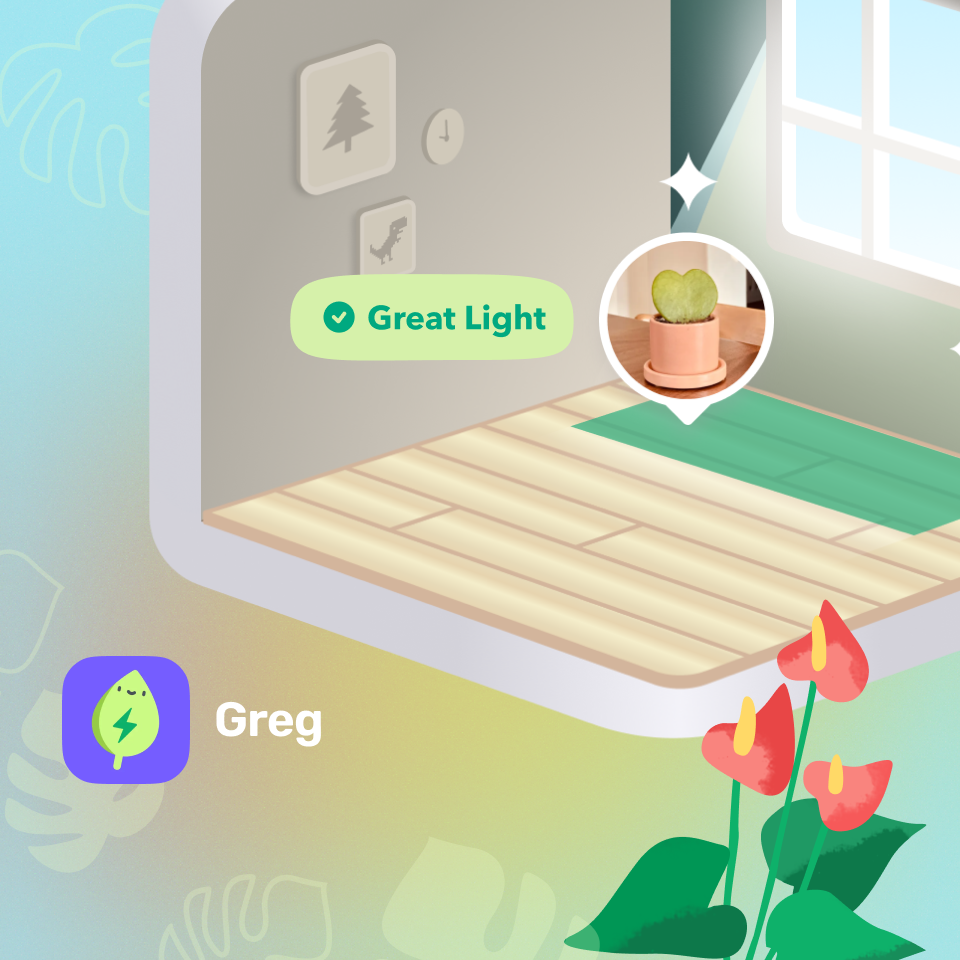Greg is a mobile app for iOS and Android that makes caring for plants fun and simple. Greg uses a combination of plant species watering data and local weather data to give users valuable insight into the needs of each of their different plant species. Greg distills this insight to help even the beginnerest of beginners keep their houseplants alive.
Overview
Greg's value prop is making it easier to keep plants alive. We'd already demonstrated that people would be willing to pay for an app to help them do this.
Still, there was much left on the table in terms of actionable information we had available but were not showing users, specifically around a plant's light and water needs.
These two pieces of information are key indicators of a given plant's likelihood to survive in any environment, and thereby key indicators of success keeping a plant alive – Greg's value prop.
An undeveloped area of opportunity we identified was in a view called the Plant Card, a section of the app where a user can see information about their plant, its species, and record actions like watering.
Hypothesis
We knew that getting the right amount of light and water – variables dependent on the plant's environment – were critical to its survival, and would increase success on a pain point for Greg users: keeping their plants alive.
We hypothesized that we would increase the number of users starting trials for Super Greg, our premium offering, by providing more useful and actionable information about a plant's light and water needs.
I served as the Lead UX/UI Designer, working alongside another UX Designer, 4 developers, and a product manager. I helped define the UX, especially in the interaction design and emotional design, and used the project to develop an iconic visual identity for Greg.
Ideation
Our ideation process was driven by team brainstorming sessions, competitor analysis, and our company's guiding principles. We focused on devising a simple and actionable way to display information for a plant's watering and light needs. Our UX Designer, Joshua Wold, combined all of our ideas and developed sketches which included different visualizations of water consumption over time and visuals of plants in different light conditions.

Together, we also imagined a plant care card could help users build an emotional connection to their plants, which would serve as a feedback system – letting you know viscerally when your plant needed something, and making you feel good when you took care of it.
This concept became known as the 'Tamagotchi/Pokemon" approach:

I started working on early designs that would incorporate feedback icons, and started working through the display of light and water needs:

Key Decisions
- The additional features were positioned behind a paywall, which users could access through a subscription. This decision was critical to our strategy of increasing paying users.
- Free users would have access to all existing functionality, as well as many of the delightful interactions. We always strove to uplift the experience for all of our users, including the free ones.
Final Design & Implementation
In the end, we committed to the Tamagotchi direction. I designed a series of animated "green beings," as we later came to call them, that represented the plant's needs and a crucial singular feedback location for the user.
If the plant needed water, or seasonal light changes meant it was no longer getting enough light, it would look sad – you would know it needed attention! When you watered it, it became happy and danced on your screen.
Part of this design sprint was also an opportunity to define an iconic visual identity for Greg. I incorporate elements that drew on wabi-sabi principles and inspiration from nature, creating a unique, charming game-like atmosphere for the app.

Our users came to love these little "plant spirits."
For the paid features, I designed a graph showing a plant's water level trajectory, helping a user anticipate the rate of consumption. I also designed an isometric display of a plant's position in the room, which dynamically changed based on the user's input data, and told them if the placement was appropriate for the plant.

Results
Post-implementation, we observed a significant increase in the conversion rate from free to paid subscriptions.


